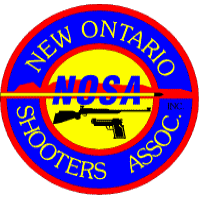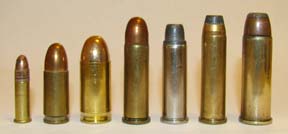About Us
Club Contacts
Junior Shooters
Upcoming Activities
Recent Activities
Member Ramblings
Books and More
Equipment Reviews
Range Rules
Range Schedules
Useful Links
Website Policy

Choosing Your First Pistol
October 2010 -- Banacek
The motivation for this article came from an evening spent at the indoor range helping supervise some new members with their initial practice shoots (required as part of the probationary members' instructional period).
Naturally they all turned up to shoot with 9 mm semi-auto pistols. I say "naturally" as these are currently the most popular pistols starring in TV shows and in movies. Everywhere you look, the heroes and villains are blasting away with them.
On reflection, the only thing that has changed since I was a youngster is the particular firearm. In my youth, with TV and movie westerns dominating the screens, we all aspired to own .45 Colt Single Action Army (SAA) revolvers. Fortunately when we started target shooting back then, folks at my gun club refocussed us newcomers onto .22 rimfire target pistols.
Not surprisingly, on this evening our current newcomers did not shoot their 9 mm's very well. You say: "They are new at this -- what do you expect?" Actually they also had sessions with other members' .22 rimfire target pistols and did much better.
With the 9 mm's, some had to deal with horrible "combat" sights with white outlines and dots that made it more difficult to have a precise sight picture. (Yes maybe these combat sights have some value for a police officer in a dark alley, but that is neither our situation nor purpose here.) Also the triggers were harder to pull and less crisp than on a target gun. And there was way too much muzzle blast and noise for someone first learning to concentrate and carefully squeeze off their shots.
And far worse, the spent 9 mm casings were ejecting and bouncing everywhere and distracting the shooters, who dearly wanted to later recover the cases (expensive) for potential reloading some day. Their attention should have been solely on sights and trigger. And they wasted way too much time looking for the cases between firing sessions.
"Practice makes perfect." It is pretty hard to do a lot of practice when every pull of the trigger represents fifty cents. For a nickel a shot, you get ten times the practice with a .22 rimfire pistol. So unless you marry into the families owning Remchester, you will never get as much practice with a 9 mm or any other centerfire round.
"But I'm going to reload my 9 mm." Let's say that's true. First spend a few hundred dollars on reloading equipment and supplies. You could have bought a lot of .22 ammo for that, and spent more time at the range rather than in the basement cranking the reloading press. And then there's the matter of the rimless 9 mm case. These cases headspace (establish their correct position in the firing chamber) based on the case mouth. 9 mm's can be choosy about how much crimp is used for reliable operation. Full strength loads are required for reliable ejection and feeding. So you need full loads of powder, and must always buy expensive factory copper-jacketed bullets.
Hmmm. We did not just shoot .22's in the olden days. Our second target pistol was likely a .38 Special or .357 Magnum revolver (which shoots .38 Special ammo just fine). They are very easy to reload as they headspace on the rim, so the amount of bullet crimp at the case mouth is less critical. They function and fire perfectly with any approved load, light or heavy. And they can use relatively inexpensive lead cast bullets (factory or homemade). Also very helpful while target shooting, the cases remain in the revolver until you choose to empty them into your hand -- no chasing them, losing them, or accidentally squashing them underfoot.
Youngsters (now there's a relative term) today want a 9 mm and that choice logically could be their third pistol, assuming they still like the idea. Let's take a brief look back at some popular cartridges.
The U.S. Army adopted the 1873 Colt SAA revolver and used it with great effect. Then in the 1890's they got sold a bill of goods and adopted a double action revolver using the comparatively puny .38 Long Colt round. In combat in the Phillipines, lots of U.S. casualties resulted from the failure of this weak round to stop the adversary. In desperation, they brought the .45 SAA revolvers out of mothballs.
Semi-automatic pistols became the new fad at the turn of the 20th century and the search was on for a new U.S. service pistol and cartridge. Testing on animals and human cadavers showed that the .45 Automatic Colt Pistol cartridge had far more stopping power than smaller cartridges. (For simplicity, regard stopping power as the ability of a cartridge to incapacitate an adversary so that he will not return fire after one solid body hit even if not fatal.) A competition between several pistol manufacturers also resulted in the Colt pistol design being chosen. (That was an interesting period of development, and makes for some great reading about some novel pistols.) The Colt pistol was designated the M1911 to reflect its year of adoption. It was renamed the M1911A1 after being slightly modified in 1924.
The M1911A1 continued as the U.S. service pistol up to the Viet Nam War. Then someone forgot the lesson of the Philippines and adopted the relatively ineffective 9 mm Parabellum. Why? It was easier to shoot than the .45 ACP and would standardize ammunition with the NATO allies. That it is ineffective in stopping power was supposedly mitigated by a larger magazine capacity, allowing the multiple shots usually needed to achieve a semblance of stopping power. Investigations of shootings by police officers using a 9 mm now often have the challenge of explaining why the officer had to shoot the felon over and over again (excessive force? -- not really, just failure by a weak cartridge). Thankfully, today many U.S. special services personnel are back to carrying something more effective, including refurbished M1911A1 .45 ACPs.
Those of you still believing/hoping the semi-auto pistol is the greatest thing since sliced bread may be less certain if you read the book by Ed McGivern reviewed in the Books and More section of this website. A revolver could be emptied into a target in the same time as perhaps two rounds could be fired from a semi-auto. The latter has its firing speed restricted by the cycle time of the recoil mechanism, while the revolver has speed restricted only by human finger skill. Five revolver rounds within 0.4 seconds were typical for Ed, and all on target. In the same way, an exhibition shooter using a manually pumped shotgun could down 7 clay targets thrown simultaneously, while the semi-auto shotgun was severely limited by its slower action cycling time.
Incidentally, I carried a 9 mm Browning H.P. for most of my military career and with unlimited free ammunition got to practice with it a lot more than most civilians could ever afford. I also had the carry option of several different model .38 Special revolvers and some heavier hardware. As for survival situations, DAMHIKT but .22 rimfires were far more effective than a 9 mm on small game. Today simply by personal preference, I don't have a 9 mm.
"You've now told me many reasons to choose a .22 rimfire as my first pistol. So which one?"
No, that you will have to decide based upon your own observations and research and what you personally like. But I will give you some general tips:
--- speak to other members and ask which .22 ammo they prefer and why;
--- an expensive brand of target ammo is not needed during this learning phase;
--- buy a brick (term for a box of about 500 rounds) of your selection, it is cheaper that way;
--- then when you test fire pistols, you will always be using the same ammo for comparison;
--- turn up regularly at the range and ask to try shooting the .22 pistols other members are using (they will gladly help);
--- if possible also try some target-quality .22 revolvers;
--- the front and rear sights should be easy to align visually for a consistent sight picture;
--- pay particular attention to the feel of the gun;
--- it should fit comfortably in your hand;
--- and give easy access to the trigger without stretching;
--- it should have a crisp, consistent trigger pull;
--- do research on the web about the strengths and weaknesses of models you are considering;
--- check out used .22 pistols for sale, and test fire before purchase (older models in good condition can be bargains);
--- if you finally decide on a semi-auto, it is helpful if the particular model will automatically keep its action open after the last shot (thus helping prove the pistol is unloaded and in safe condition after firing).

Certainly you can choose to buy a 9 mm pistol (preferably after the .22); just be sure you know what you are getting -- and giving up.
Cartridges Left to Right: .22 LR Rimfire, 9 mm FMJ, .45 ACP FMJ, .38 Special FMJ, .38 Special +P Police, .357 Magnum, and .44 Magnum.
back to Table Of Contents for Member Ramblings
Warning and Disclaimer. Only the most current printed Shooting Rules and Range Standing Orders and Match Standing Orders as issued by the N.O.S.A. Executive are official and they should be read, understood, and followed. If there is any question as to interpretation of a rule, or safety of a practice, immediately ask a member of the Executive or a Range Safety Officer before placing yourself or anyone or anything else at risk. Any activity involving firearms has inherent dangers. Some contents on this website may include personal opinions and experiences or practices that should not be emulated. Everyone viewing this website, or any other website or book or magazine or pamphlet or media source, is cautioned to seek professional advice first about anything written or implied or inferred. Your safety is your personal responsibility.
Copyright © 2010 - 2012 New Ontario Shooters Association. This site is copyrighted and no content may be reproduced by any means, including electronic, without written permission except for strictly personal use. Other websites wishing to post a link to this site are welcome to do so.